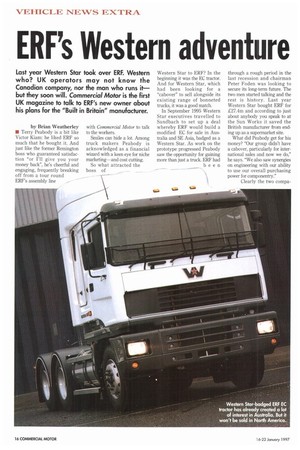ERF's Western adventure
Page 18

Page 19

If you've noticed an error in this article please click here to report it so we can fix it.
Last year Western Star took over ERE Western who? UK operators may not know the Canadian company, nor the man who runs it— but they soon will. Commercial Motor is the first UK magazine to talk to ERF's new owner about his plans for the "Built in Britain" manufacturer.
by Brian Weatherley • Terry Peabody is a bit like Victor Kiam: he liked ERF so much that he bought it. And just like the former Remington boss who guaranteed satisfaction "or I'll give you your money back", he's cheerful and engaging, frequently breaking off from a tour round ERF's assembly line
with Commercial Motor to talk to the workers.
Smiles can hide a lot. Among truck makers Peabody is acknowledged as a financial wizard with a keen eye for niche marketing—and cost cutting.
So what attracted the boss of Western Star to ERF? In the beginning it was the EC tractor. And for Western Star, which had been looking for a "cabover" to sell alongside its existing range of bonneted trucks, it was a good match.
In September 1995 Western Star executives travelled to Sandbach to set up a deal whereby ERF would build a modified EC for sale in Australia and SE Asia, badged as a Western Star. As work on the prototype progressed Peabody saw the opportunity for gaining more than just a truck. ERF had been through a rough period in the last recession and chairman Peter Foden was looking to secure its long-term future. The two men started talking and the rest is history. Last year Western Star bought ERF for £27.4m and according to just about anybody you speak to at the Sun Works it saved the British manufacturer from ending up as a supermarket site.
What did Peabody get for his money? "Our group didn't have a cabover, particularly for international sales and now we do," he says. "We also saw synergies on engineering with our ability to use our overall purchasing power for componentry."
Clearly the two compa flies think and build alike even if their products don't look alike. Two companies can also wield a bigger stick against component suppliers than one, although Peabody insists he won't be heavy handed: "It won't be in that manner. It should put us on another level. It starts on things like gearboxes and goes through a whole lot of lesser components such as air conditioning, wheels—you can go through the whole product line. It works both ways."
The dashboard for Western Star's bonneted Constellation range is already built in Britain and according to Peabody, "ERF is helping us make that much more efficient. It's also researching a number of avenues that we feel have economies for Western Star."
One way to maximise economies of scale would be to share a common cab structure. "We may look at one in time," says Peabody "Right now the ERE cab isn't that old and the Constellation is brand new— but it could make good sense in the future."
Despite the opportunities offered by modular design, Peabody is sceptical about the concept of a world truck, "I can't foresee the day when you're going to get countries so diametrically opposed on standards coming together that everything can be built the same," he says.
ERF wasn't the only European manufacturer Western Star talked to when it was looking for a cabover. Peabody won't say which the others were. "We looked at several but they weren't satisfactory."
Australian operator reaction to the Western Star-badged EC is extremely positive. "Many of the first orders are going into Bdoubles (a tractor pulling two full-length semi-trailers)—that's a market that's growing rapidly," reports Peabody. "It's very attractive as a B-double as many bonneted Western Stars are too long. There's a very urgent application for it and a number of orders have been made sight unseen."
He is aiming to sell 200 Western Star ECs in Australia in its first year, specced as 6x4s with either Cummins MI I or NI4 engines, "although that will eventually grow to 400 to 500 units", he says.
In a badge engineering exercise it will also be sold in New Zealand through Western Star's own outlets, alongside EREbadged ECs retailed through ERF's own Kiwi dealers. Peabody maintains sales will be "totally incremental".
If the EC is the truck Western Star wants, why not sell it in North America where there's real volume? Even with a US. style driveline Peabody is unconvinced: "We'd very much • like to do that but to make that truck viable from an axle load and weight point of view will take an enormous amount of engineering work and cost. We're weighing up the economics to see if it works—it's perhaps questionable."
However, Peabody does see opportunities for the ERF low-floor crew cab in the municipal and refuse market.
Will British operators still recognise an ERE tractor in five years' time—not least in terms of what's on the grille?
"There's no reason to change or have a Western Star badge on it," says Peabody. "Western Star means nothing here. Over the last few days I visited perhaps 30 to 35 operators---not one was interested in a bonneted truck!".
But ERF's new boss is adamant that come the millennium the ERF tractor will have changed. "It will be far, far different from today's truck, not only in terms of fuel economy but also in the ability of operators to control big fleets over long distances through the use of electronics."
As vehicles change so will operators, predicts Peabody: "Most people who buy trucks are going to keep them longer. Those that traditionally held them for three years will go to five, those for five will go to seven—because the quality of the product is getting better. But however the market goes we'll be with it"












































































































